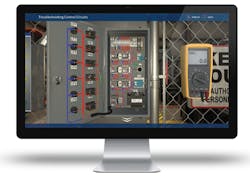Simulation training is catching on
Editor's Note: This post was sponsored by TPC.
TPC leads the industry in training and workforce management solutions by offering a best-in-class learning management system (LMS), 200 instructor-led training courses (virtual or in-person), thousands of digital training options, cloud-based workforce management solutions, consulting services, and continuing education and safety programming. TPC has helped more than 40,000 client sites globally to train over 3.5 million skilled workers, and most recently has extended their simulation module library to include VFDs and PLC-based industrial sensors.
We recently caught up with Michael McKenzie, VP Products at TPC, where he manages TPC’s cloud-based 3D electrical troubleshooting simulation products. Michael is a training and development professional with over 20 years of experience, and we asked him about the role of simulations in best-in-class maintenance and reliability training.
Q: In a general sense, what makes simulation training so valuable for businesses?
A: What makes simulation training so valuable is that it saves time and money for businesses. It saves time as learning is done virtually. The learner does not have to take the time to physically get the parts and set up equipment. It saves the business money since simulations:
- Do not require downtime of equipment while the trainee is learning
- Enforce safe working habits that can prevent costly downtime due to accident or injury
- Teach best practices and efficient techniques that speed up the troubleshooting process.
Q: What qualities set simulation training apart from other training options?
A: Simulation training employs a learn by doing model that engages the student on a much deeper level than other training options. In our simulations, the student is given increasingly difficult faults where it is up to the student to fix the problems. Using our five-step systematic troubleshooting process, the trainee develops the skills to take all of the necessary actions to diagnose and resolve issues.
Q: What are the key benefits that simulation training can drive at a facility?
A: Learning to anticipate, troubleshoot and solve issues in an environment that closely resembles reality contributes to a worker population that is more efficient, and accurate in the identification and resolution of issues at a facility. In addition, the simulation stresses the importance of safety and best practice requirements. Our simulation training develops the critical skills necessary to repair electro-mechanical equipment accurately, safely, and efficiently resulting in reduced downtime and repair costs.
Q: Specifically, how can simulation training help plant teams achieve meaningful reductions in downtime, whether planned or unplanned?
A: Simulation training decreases downtime in four ways.
- Trainees are learning on simulated equipment and not tying up equipment on the plant floor. Machine downtime for training is significantly reduced.
- Trainees gain experience during the troubleshooting process. Following the five-step approach instills though processes that result in efficient decision making. When machines go down, trainees have a systematic approach to tackle the issue and get the machinery up and working in a timely and safe manner.
- With the large number of faults available to the trainees, trainees become more confident and proficient in diagnosing issues as they are exposed to a wide variety of potential problems. This increased confidence can inspire them to anticipate scenarios and to look for patterns in equipment behavior, addressing issues before they become a problem.
- The simulation training reinforces safe work practices which leads to a safer environment with less chance of accident-related downtime.
Q: Beyond the cost savings associated with reduced downtime, where else does simulation training have a positive impact on the financial bottom line?
A: Another cost saving opportunity that simulation offers is reduced repair cost. Our simulations track the cost of repairs, which include the technicians’ time, and the replacement part costs. Trainees are penalized when good parts are unnecessarily replaced or when they take too long to resolve an issue. The cost of reordering and managing excess parts are an additional cost saving that can be reduced through increased accuracy in troubleshooting issues.
Readers interested in learning more can request a no-obligation demonstration of TPC’s online simulation training systems at https://plnt.sv/2207-TPC.
This story originally appeared in the July 2022 issue of Plant Services. Subscribe to Plant Services here.

